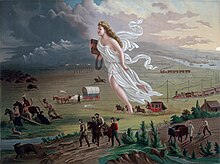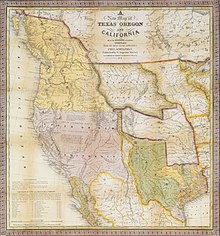Manifest Destiny

Under Manifest Destiny ( German about "obvious determination" or "Manifest Destiny") refers to an American doctrine of the 19th century. It says that the United States would have a divine mandate to expand existing particular the mid-19th century western frontier ( Frontier ) towards the Pacific .
Manifest Destiny was never just a policy or ideology; it was a general term that united elements of American exceptionalism , nationalism, and expansionism in an overarching sense of mission . The exploration and planned “conquest” of space can also be seen in this tradition .
Many American pioneers argued that the ideals of freedom and the nation were far-reaching and should be brought into the new lands by expanding the reach of the nation (and hence its borders). Two centuries earlier, Massachusetts Bay Colony Governor John Winthrop had claimed that his colony was the City on the Mountain and would demonstrate to the rest of the world the way of life of a free, godly society. Continuing this idea, many argued that it was a divine mandate to expand the United States across the entire North American continent. The Young America Movement under Franklin Pierce actively supported this vision. The background was the religious view that whites were predestined for this job.
terminology
The phrase that means obvious ( or inevitable) fate was coined by the New York journalist John L. O'Sullivan in an article in The United States Democratic Review in 1845 when he wrote that it was “the obvious Destiny of the nation to expand and take possession of the entire continent which Providence has entrusted to us for the development of the great experiment of freedom and an alliance of sovereigns united. "
theory and practice
In 1846, politicians used this idiom to justify territorial expansion across the entire North American continent by instilling a missionary awareness among the population. Theoretically, the intention was to convey the ideals of democracy and civilization to all peoples; in practice it often meant the exclusion of indigenous Americans and people with non-European ancestry.
The west expansion

As US citizens advanced west, serious conflicts with both Indigenous Americans and Mexico were inevitable. Already badly decimated by disease, the Indians were unable to oppose the endless stream of white settlers and the accompanying military; the Indian decline and Indian wars are dark chapters in American history. The conflict with Mexico was less dramatic, but it brought enormous land reclamation for the US settlers with the Mexican-American War and its end, the Treaty of Guadalupe Hidalgo . President Polk recorded in his diaries that he was determined to take possession of any Mexican territory that fell into US hands.
When the US had fulfilled the Destiny Manifesto to the point where it had completely occupied the country as far as the Pacific Ocean, the British shipowners were forced to move their operations north to the less populated Canadian area.
Effects

The consequences of the western expansion towards the end of the 19th century were probably more far-reaching than its carriers could ever suspect. The discovery of gold in 1849 (see gold rush ) and other minerals accelerated the growth of prosperity and wealth for a few industrialists. The American Civil War and the liberation of slaves encouraged further immigration to the new lands of the west.
Belief in the Destiny Manifesto was one of the driving forces behind the Mexican-American War of 1846–1848, in which the later states of Nevada , Arizona , Utah , California and New Mexico were conquered.
On December 2, 1845, US President James K. Polk announced to Congress that the Monroe Doctrine was to be consistently enforced and that the United States would aggressively expand its sphere in the West. The Destiny Manifesto and many statements regarding moral, political and often racial superiority served to justify the deportation of the Indians. Similar teachings such as B. The White Man's Burden by Rudyard Kipling , were simultaneously used by Europeans elsewhere in the world to justify colonial conquests in Africa and Asia .
The term "Manifest Destiny" is also sometimes mentioned in Canada when it comes to Canadian-American relations. Some Canadians believe that the US has never really given up on its goal of incorporating Canada into fulfilling Manifest Destiny.
Manifest Destiny finds a global continuation in American exceptionalism as a political doctrine of the 20th and 21st centuries.
literature
- Sam W. Hayes, Christopher Morris (Eds.): Manifest Destiny and Empire: American Antebellum Expansionism . Texas A&M University Press, College Station, Texas 1997, ISBN 0-89096-756-3 .
- Reginald Horsman: Race and Manifest Destiny: The Origins of American Racial Anglo-Saxonism . Harvard University Press, Cambridge, Massachusetts 1981, ISBN 0-674-74572-8 .
- Frederick Merk: Manifest Destiny and Mission in American History: A Reinterpretation . Knopf, New York 1963.
- Anders Stephanson: Manifest Destiny: American Expansionism and the Empire of Right . Hill and Wang, New York 1995, ISBN 0-8090-6721-8 .
- Albert K. Weinberg: Manifest Destiny: A Study of Nationalist Expansionism in American History . Johns Hopkins, Baltimore 1936.
- Jürgen Heideking: History of the USA . 3rd edition, Franke, Tübingen 2003, ISBN 3-8252-1938-0 , pp. 145-146.
- Udo Sautter : History of the United States of America (= Kröner's pocket edition . Volume 443). 7th, completely revised and enlarged edition. Kröner, Stuttgart 2006, ISBN 3-520-44307-4 , pp. 191-195.
- Howard Zinn: A History of the American People. Nikol, Hamburg 2013, ISBN 978-3-86820-192-5 , pp. 127-168.
Individual evidence
- ↑ Martha A. Sandweiss: John Guest, American Progress, 1872. In: Picturing US History . Retrieved January 1, 2019 (English): "In her right hand she carries a book — common school — the emblem of education and the testimonial of our national enlightenment ..."
- ↑ z. B. Igor J. Polianski, Matthias Schwartz (ed.): The trace of the Sputnik. Cultural-historical expeditions into the cosmic age. Campus-Verlag, Frankfurt am Main 2009, ISBN 978-3-593-39042-0 , p. 72.
- ↑ Hilde Eliassen Restad: American Exceptionalism: An Idea did Made a Nation Remade and the World. Routledge, New York 2014, p. 40.
